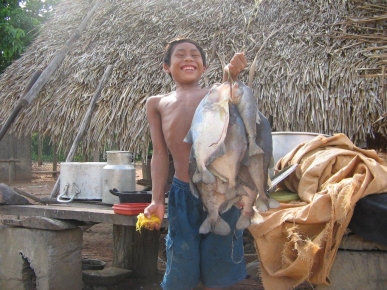Incentive for change: Deforestation in the Amazon (Part 3)

A Panará boy with his catch of the day.
Image by S. Schwartzman/EDF
Today, the Panará people once again live on ancestral lands in the Amazon rainforest. They live as they have always lived, hunting, fishing and planting gardens of corn, peanuts, bananas, cassava and sweet potatoes. But there is now an urgent, ongoing debate among them over what it will mean to be Panará in the future.
Like many of his people, Krentoma, the Panará leader, wants access to the outside world, to modern communications and medicine and more. And he wants to do it without letting loggers or gold miners onto his land.
Indigenous people in the Amazon are the core of a huge network of parks and sustainable-use reserves, comprising 40 percent of the remaining Amazon, which is the main reason that Brazil was able to reduce deforestation by almost 80% in the last eight years. This is forest conservation on a scale you can literally see from the moon.
Many ranchers and soy farmers would also like to stop clearing forest and grow more on less land. But as long as it’s more profitable to clear the land than to keep the rainforest alive, whether you’re the Panará or a local cattle king, the pressure to cut down the forest will only grow.
Carbon markets can preserve the rainforest forever
There are already signs that the powerful agriculture lobby in Brazil’s Congress wants to open up Indian lands and parks in the Amazon to exploitation, so the need to create economic incentives for reducing deforestation is growing.
One way to achieve these goals is for Brazil, Amazon states and indigenous peoples to get credit for reducing deforestation in carbon markets. That means getting paid for saving forest land.
The idea under discussion in California and other emerging carbon markets is that states or countries that reduce their deforestation below historical levels (and verify those reductions with satellite photos) would sell carbon credits to companies or governments that have to reduce their emissions.
The rules of these carbon sales would ensure that all those responsible for reducing deforestation would benefit: farmers who stop clearing forest and grow more on less land; indigenous peoples who defend their forests; government agencies that enforce the laws against illegal deforestation and measure total deforestation and emissions.
EDF and Brazil’s Instituto Socioambiental (ISA) have talked to The Panará and 17 other indigenous groups about this idea of being paid for such so-called ecosystem services, and they support it. They are proud of the role they play in helping Brazil reduce deforestation and CO2 emissions. And they see it as only fair that they should be paid for this work.
EDF and ISA, among others, are working to make that vision a reality. Several governments, including Norway, Germany, France and the United Kingdom, have promised some $5 billion for reducing emissions from deforestation. But the money has been slow to materialize, leaving the people of the Amazon to wonder if the idea of carbon credits will ever become a reality.
That’s why, when I accompanied Jennifer Haverkamp, EDF’s International Climate director, to Krentoma’s village in 2010, he told her: “You all come here and tell me about carbon projects. That’s great, but where are they?”
It’s not just indigenous peoples who feel this way. So do many farmers and ranchers and Amazon state governments. They, too, want to preserve the unique world in which they live. But so far, the biggest carbon market in the world, the European Union, doesn’t accept emissions reductions from deforestation for credits.
This is why the latest sign of progress is so important. Recently, a group of experts convened by California, the Brazilian state of Acre and the Mexican state of Chiapas recommended ways for California’s carbon market – the world’s second largest—to include emissions reductions from deforestation in its system.
This would send a critically important economic signal that carbon credits are real and that they can help the people of the Amazon lead better lives by conserving the world’s greatest rainforest.











